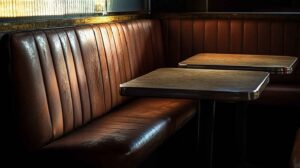19 Sep What Are Restaurant Booths Made Of?
Restaurant booths are typically crafted from vinyl, leather, and fabric upholstery to ensure durability, aesthetics, and comfort for diners. These materials offer various advantages, such as being easy to maintain, visually appealing, and creating a cozy ambiance. The choice of materials plays a significant role in shaping the overall dining experience, offering attractive and comfortable seating. Understanding the factors that impact booth design, durability, and upholstery choices can help restaurant owners create an inviting atmosphere that boosts customer satisfaction and enjoyment.

Common Materials for Restaurant Booths
When selecting materials for restaurant booths, businesses often choose durable and visually appealing options like vinyl, leather, and fabric upholstery. Vinyl is popular because it’s easy to maintain and resists stains, making it perfect for busy dining areas. It also comes in various colors and textures, allowing for customization to match the restaurant’s design. Leather offers a luxurious feel and enhances the ambiance of upscale establishments. Its durability and timeless look make it a favorite for creating a high-end atmosphere. Fabric upholstery provides a warm and inviting feel, ideal for casual dining environments. With endless patterns and designs, fabric allows creativity in booth design, adding personality to the space. Each material brings unique qualities to the booths, catering to different styles and preferences in the food industry.
Factors Influencing Booth Design
Several elements, including space efficiency, customer comfort, and visual appeal, influence the design of restaurant booths. For space efficiency, restaurant owners must consider the layout and how booths can maximize seating without overcrowding the area. Thoughtfully placed booths can offer diners privacy while optimizing available space.
Customer comfort is another critical factor in booth design. The dimensions, such as backrest height and seat depth, should be carefully planned to ensure diners can relax and enjoy their meal. Additionally, the choice of upholstery and padding significantly affects the comfort level.
Visual appeal is also vital, as it shapes the restaurant’s overall atmosphere. The design, color, and materials used should align with the restaurant’s theme, creating a cohesive and visually pleasing dining experience. By balancing space efficiency, customer comfort, and aesthetics, restaurant owners can design booths that enhance the guest experience.
Durability of Restaurant Booths
Maintaining the durability of restaurant booths is essential for preserving a high-quality dining environment. Several factors contribute to the long-lasting nature of restaurant booths:
- Material Choice: Using high-quality materials like solid wood, metal frames, or durable plastics can significantly improve the booth’s lifespan. These materials resist wear and tear, ensuring longevity.
- Construction Methods: The craftsmanship of the booth plays a crucial role in its durability. Reinforced joints, sturdy hardware, and expert assembly all contribute to the booth’s strength.
- Maintenance Routines: Regular upkeep, such as cleaning spills promptly and addressing any issues early, helps prolong the life of restaurant booths. Proper care ensures the booths remain in top condition over time, upholding a high quality standard.
Upholstery Options for Booths
Choosing the right upholstery for restaurant booths is crucial for both aesthetics and comfort. When making this decision, restaurant owners should consider factors like durability, ease of cleaning, and how well the upholstery complements the restaurant’s overall design.
Common upholstery materials include vinyl, leather, fabric, and faux leather. Vinyl is favored for its durability, easy cleaning, and stain resistance, making it ideal for high-traffic areas. Leather provides a luxurious and durable option but requires more maintenance to prevent cracking or fading. Fabric offers a wide variety of colors, patterns, and textures, allowing for customization, though it may need more attention to keep clean. Faux leather offers a cost-effective alternative to genuine leather, with similar aesthetics and easy upkeep.
Ultimately, the choice of upholstery should reflect the restaurant’s style, budget, and maintenance requirements, ensuring a welcoming and visually appealing dining environment.
Other Articles:

